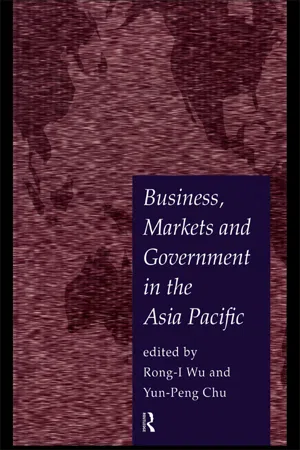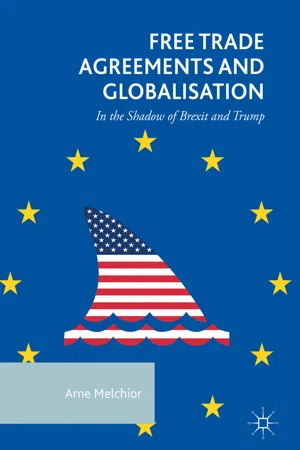Economics
International Regulatory Cooperation
International Regulatory Cooperation refers to the coordination and harmonization of regulations and standards across countries to facilitate international trade and investment. It involves the sharing of information, best practices, and technical expertise among regulatory agencies to ensure that regulations are effective, efficient, and consistent with international norms and standards.
Written by Perlego with AI-assistance
Related key terms
Related key terms
1 of 4
Related key terms
1 of 3
3 Key excerpts on "International Regulatory Cooperation"
- eBook - ePub
Business, Markets and Government in the Asia-Pacific
Competition Policy, Convergence and Pluralism
- Yun-Peng Chu, Rong-I Wu(Authors)
- 2002(Publication Date)
- Routledge(Publisher)
This is not meant to suggest that there is a single model available for replication but rather that the growth of international trade and investment is likely to require continuing adjustments in regulatory systems and increased consultation on approaches taken to regulation and its reform. Expanded international cooperation and consultation could result in better understanding of the economic consequences of regulatory reform as well the positive linkages between regulatory reform and other economic objectives such as increased foreign investment and access to technology. These features are especially important for developing economies and economies in transition. Greater international consultation on regulatory matters can also serve to reduce or ameliorate trade frictions arising from differences in regulatory regimes.In this complex mix, competition policy has been an important policy tool employed in some jurisdictions not only to address private anticompetitive practices but also to ensure that regulatory reform as well as the conduct of firms in regulated industry furthers competition. For developing countries and economies in transition, the introduction of competition laws and norms is an important measure to strengthen market forces. The design and implementation of competition laws, along with the mix of enforcement priorities and instruments will need, of course, to reflect the technical capacity as well as the institutional capabilities and endowments of the given political economy.48 As this discussion has sought to amplify, the role for competition policy in deregulating markets is rarely straightforward, and even countries with well-established competition policy regimes are modifying and modernising their competition laws and policies in light of global economic trends and new learning.Further international consultation on competition policy and its role in regulatory reform is both necessary and useful. While this author agrees with the view that the WTO does not currently have the competence to deal with substantive competition law and indeed should not seek to develop a comprehensive global competition code, there are some aspects of the problem that could benefit from substantial consideration at the international level at this early stage. - eBook - ePub
- Alasdair Young(Author)
- 2017(Publication Date)
- Routledge(Publisher)
The existing literature on the EU’s experience of regulatory co-operation, while also tending to accentuate the positive, is much more alive to the limits of EU influence than the literature dealing with regulatory competition. Regulatory co-operation occurs through either power-based bargaining between states outside institutional frameworks or rule-mediated negotiations within international organizations (Büthe and Mattli 2011: 19; Simmons 2001: 598–9; see also Newman and Posner 2015). The literature on regulatory co-operation suggests that different power resources have different utilities in these different types of interaction. The tendency of the regulatory co-operation literature to focus on individual or closely related cases, however, has masked the implications of this insight.Table 1 Forms of regulatory interactionDiffusion Co-operation Competition Power-based bargaining [Coercion or inducement through conditionality] with the prospect of exclusion [Emulation] without the prospect of exclusion [Learning] Rule-mediated negotiation The regulatory co-operation literature has focused on the same regulatory power resources as the regulatory competition literature: market size; rule stringency; and regulatory capacity. Because regulatory co-operation implies strategic interaction and because the EU is an international organization as well as an international actor, there is also an issue about the EU’s ability to pursue a common position; to be internally cohesive (Conceição-Heldt and Meunier 2014: 969; Van Schaik 2013: 176). The existence of an EU rule, however, significantly eases the problem of cohesiveness (Quaglia 2014b; Young 2002). Regulatory co-operation authors have also been much more explicit in considering how the EU’s power and preferences relate to those of other key actors.The critical starting assumption in the literature on regulatory co-operation is that each party would prefer its own standard to be adopted as the common one, as this brings benefits without the costs of adjustment (Büthe and Mattli 2011: 12; Drezner 2007: 32). Certainly where the EU has existing rules, which is usually the case, the EU is assumed to want regulatory co-operation to occur on its own terms (Damro 2012: 686; Kelemen 2010: 341; Smith 2010: 937). - eBook - ePub
Free Trade Agreements and Globalisation
In the Shadow of Brexit and Trump
- Arne Melchior(Author)
- 2018(Publication Date)
- Palgrave Macmillan(Publisher)
The WTO did not set the standards, but the reference to the standards of, for example, Codex Alimentarius gave these standards a new legal significance. In the regulatory field, there are many plurilateral organisations (cf. examples above)—many of them less known—that that are important building blocks for global regulatory cooperation. It is beyond the scope here to analyse and draw firm conclusions on how this is to be done in each field; for example, trade agreements for financial services could be linked to International Regulatory Cooperation. In principle, such linkages should be explored in fields where regulatory issues are important. Rather than considering regulation as “necessary evil” in a setting where trade liberalisation is the only main objective, trade policy could seek for more harmony. In some areas, this could also facilitate trade negotiations that may “beat around the bush” unless regulatory issues are addressed. Also in the economic models, the value of regulation should be taken into account; free trade in toxic chemicals is not welfare -enhancing. An obstacle to International Regulatory Cooperation is that institutional approaches differ across countries, for example, the scope of legislation versus voluntary standards where, for example, the EU and the USA are very different. For example, a regulation may set health-related requirements for a product or process, and a standard may be a way of fulfilling these requirements. In the EU, some standardisation bodies are officially recognised as European Standardisation Organisations and create EU -wide standards that replace national standards. Contrary to this centralised procedure, the USA has a more decentralised pattern of standardisation, with a large number of competing standard-setting bodies (Kommerskollegium 2013). In the centralised European system, standards have a semi-legal status, but in the USA this is not the case
Index pages curate the most relevant extracts from our library of academic textbooks. They’ve been created using an in-house natural language model (NLM), each adding context and meaning to key research topics.
Explore more topic indexes
Explore more topic indexes
1 of 6
Explore more topic indexes
1 of 4


